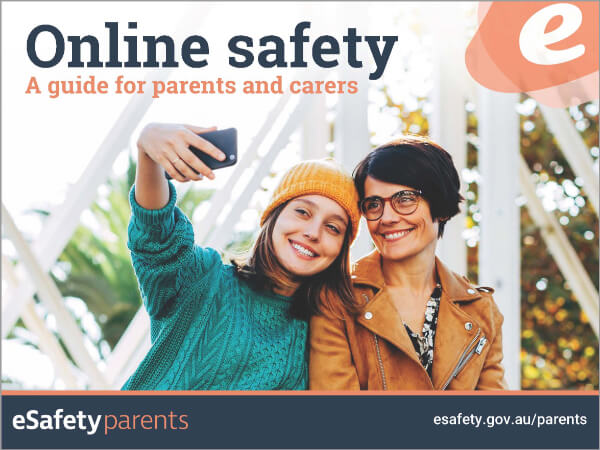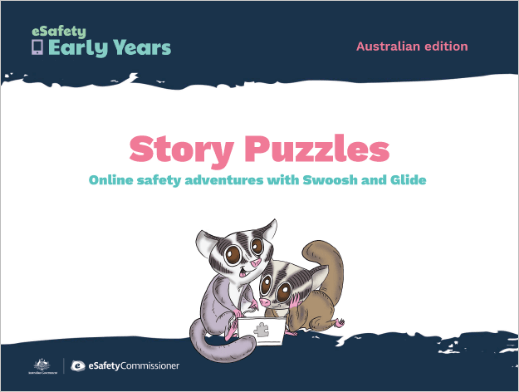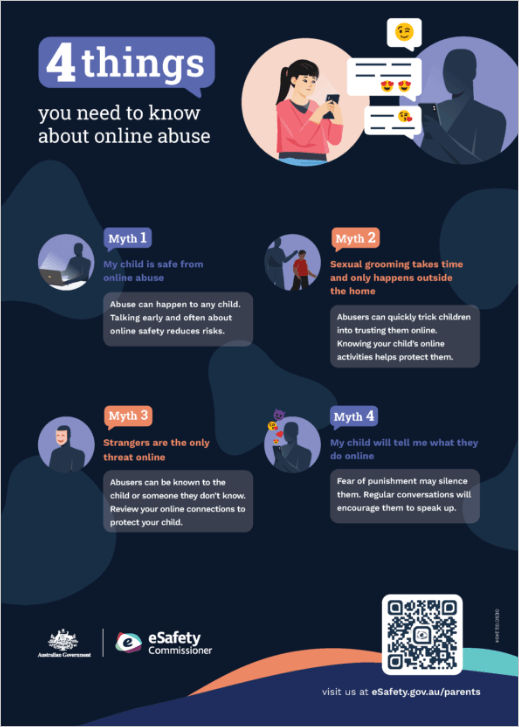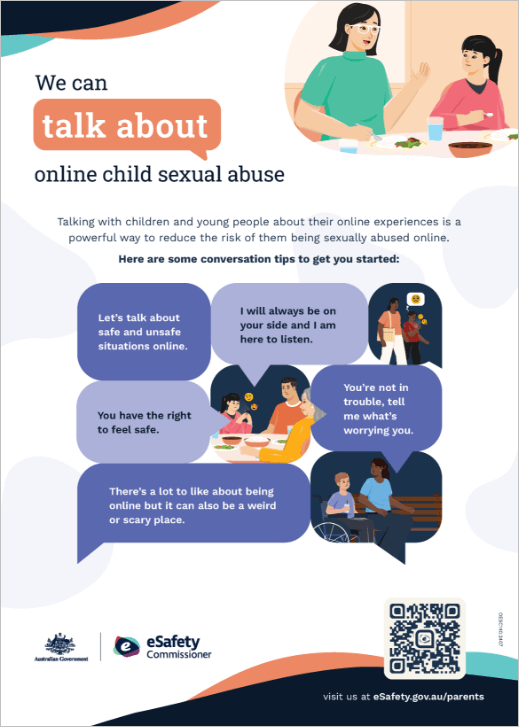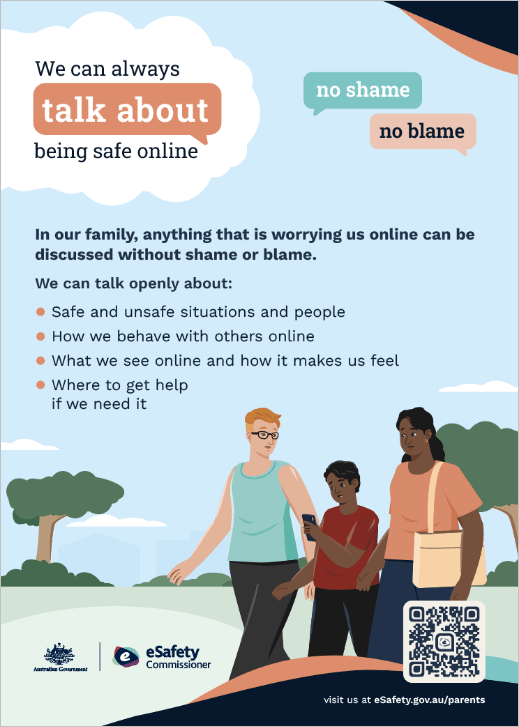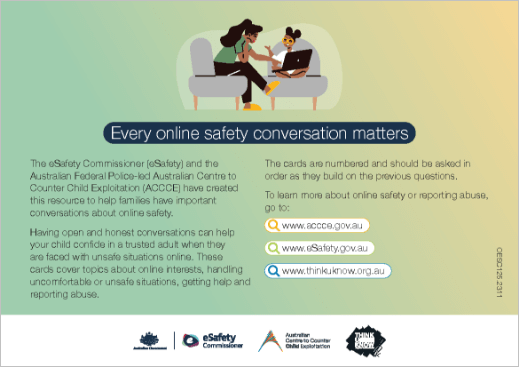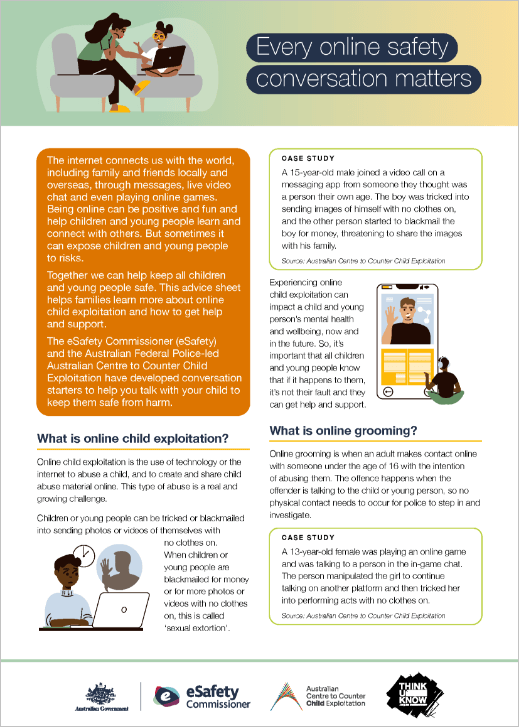How to help families keep children safe online
Organisations, services and practices can play a key role in sharing trusted advice with parents and carers about online risks, including how to prevent and deal with online abuse of children and young people.
On this page:
Stay up to date
Sign up for events, resources and the latest advice to help you support families and communities stay safe online.
Social media changes
As of 10 December 2025, many social media platforms are not allowed to let Australians under 16 have an account.
What you need to know:
- As of 10 December 2025, Facebook, Instagram, Kick, Reddit, Snapchat, Threads, TikTok, Twitch, X and YouTube are required to take reasonable steps to prevent Australians under 16 from having accounts on their platforms. See the latest list.
- Under-16s are still allowed to see publicly available social media content that doesn’t require logging into an account.
- Most standalone gaming and messaging apps, as well as many services that support health and education, are not affected by the new law.
- There are no penalties for under-16s who access an account on an age-restricted social media platform, or for their parents or carers. This is about making the platforms take greater responsibility for the safety of children – they face penalties of up to $49.5 million if they don’t take reasonable steps to implement the changes.
For more, visit eSafety’s frequently asked questions.
Join a free information webinar about the new laws.
Share these resources with parents or use them in your organisation, service or practice to talk about the changes and answer children and young people's questions about online safety.
Explore eSafety resources for young people
- FAQs for young people – answers to common questions
- Get-ready guide for under 16s, with a personal action plan to fill out
- I need help – something has happened online
Supporting families to keep children safe
A community organisation, service or practice is often a place where families and carers connect with other people. It can also be a place where they find refuge and help in difficult times.
Your role is especially important if you’re in contact with people who experience discrimination or marginalisation, or who may not otherwise have strong support networks. You can be a safe and trusted source of online safety information and advice for people who:
- may have low levels of trust in government, such as some refugee and migrant communities, or people experiencing multi-generational trauma
- experience other barriers, such as literacy, financial distress or insecure or unsafe living situations, that stop them accessing information about online safety.
How to start a conversation
Starting a conversation about online safety can be critical for those you support. eSafety resources can help you discuss topics ranging from ways to prevent online abuse, through to how to help someone who's been harmed.
On this page we've linked to different options that you can use in your organisation, service or practice to help you explain online safety to children, young people and families. You can share the resources with parents and carers, so they can start their own conversations about online risks and what to do if things go wrong.
There's a ready-to-use toolkit to help you communicate about online safety in your community. It includes information for your own website or intranet, messages for social media posts, and posters for noticeboards.
There's also a limited range of free printed resources that you can order to support families in your community.
In addition, we have provided answers to common questions you may be asked by parents and carers, so you can be confident you’re giving the most useful advice.
It's also a good idea to read these other pages for communities first:
Ready to use communications toolkit
Working together to promote online safety: Ready-to-use communications for organisations, services and practices.
How we talk about children and young people
Throughout eSafety’s website and resources we use ‘families’ and ‘parents and carers’ to talk about the adults who support children. When we use these terms, we include the mums, dads, parents, carers, aunties, uncles and other supportive adults who we know can play an important role in helping children play, learn and grow. When we talk about ‘children’ we mean everyone under 18 years old. Sometimes we include the term ‘young people’ because many teenagers don’t like to be called children. We also know that parents and carers continue to support and nurture young people beyond their teens and our advice can be useful for them as well.
General online safety information
Online safety for every family
Easy-to-read advice sheets, short videos and conversation starters, available in languages other than English, to help parents and carers talk with their child about online safety. The resources include safety tips and provide important information about what to do if something goes wrong online.
eSafety's Online safety ebook
The book covers key online safety issues and gives practical tips and advice on what to do if things go wrong. It can be downloaded in languages other than English and includes a list of important services that parents and carers can access for extra support.
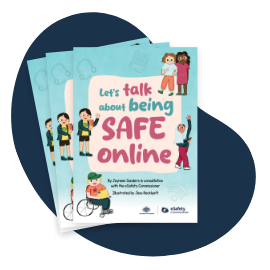
'Let’s talk about being safe online' family book
eSafety worked with expert author, Jayneen Sanders, to develop this book, which families can read or watch here: ‘Let’s talk about being safe online’.
The book is designed to help children from age 7 and their parents and carers explore online safety together through simple, open conversations. Every child has different levels of online experience, so it’s important to support them in having safe and positive interactions, wherever they’re at in their journey.
‘Let’s talk about being safe online’ teaches essential skills to help children stay safe, such as understanding consent, sharing responsibly, protecting personal information and recognising unsafe situations.
Jayneen is an experienced teacher, author and mother of three. She is a passionate advocate for respectful relationships, gender equality and personal body safety education.
The book is also available as a printed hardcopy, free of charge to Australian residents.
Watch this video with Jayneen talking about the family book and its online safety messages.
| Audio |
|---|
Right from the beginning of their online journey children need to know if they need help that they can come to you and they're not going to get in trouble. This book has been designed and written for children seven years and older, using concepts and language that is suitable to their stage of development. |
Parents don't need to have all the answers they just need to be open, calm and curious, and children then will feel safe to come to them if they have any concerns or worries. |
When children are online, it should be fun and comfortable for them. However, they may see things that are not appropriate. So they need a safety network. |
A safety network is three to five safe adults that they could come to if they feel that they are in trouble or they need help. |
These safe adults will listen to them, believe them and get them help and support. We don't want children to be scared to go online. We don't want children to not be aware of the risks of online. |
So we actually need to talk about those risks, but in a way that is age appropriate and in a language they understand and in a way that is safe for them. |
The 'Let's Talk About Being Safe Online' book will help you start these crucial conversations and ultimately help to keep your child safe. Go to the eSafety website for more. |
Author Jayneen Sanders talks about the book's messages
Download
Promote the online safety family book in your organisation, service or practice, with these resources. They include posters and a social tile.
eSafety’s Early Years program for educators
eSafety recognises that early years educators work closely with the families of the children in their care.
Explore the Swoosh, Glide and Rule Number 5 book and video (video also available with Auslan interpretation), posters and resources for early years centres and resources for families. You can also use or share eSafety's Online safety book for under 5s.
Dealing with online abuse
Quick guides
These resources provide key online safety information and steps for reporting cyberbullying, adult cyber abuse and image-based abuse.
The cyberbullying quick guide is also available in Arabic, Punjabi, Simplified Chinese and Vietnamese.
The adult cyber abuse quick guide is also available in Arabic, Dinka, Filipino, Hindi, Korean, Nepali, Persian, Punjabi, Simplified Chinese and Traditional Chinese, Spanish, Thai and Vietnamese.
The image-based abuse quick guide is also available in Arabic, Dinka, Italian, Greek, Korean, Malay, Punjabi, Simplified Chinese, Somali, Spanish, Thai and Vietnamese.
How to report cyberbullying poster
Webinars for parents and carers
eSafety has free webinars which provide parents and carers with the knowledge, skills and tools to support their children to have safe online experiences.
Order resources
To order free resources such as posters, books and conversation cards, visit our page on How you can protect children from online harm.
Talking about online child sexual abuse
This suite of resources will help parents and carers understand how to protect children from sexual abuse online, including how to recognise the warning signs and where to get help.
You can get them started with these short videos and other easy resources.
There’s also further advice on what online behaviours to expect at different ages and how to have suitable conversations about sexual abuse with children and young people. The age ranges are only a guide – parents and carers will know their child best, so they should follow the tips that match their child’s maturity.
Talking about online child sexual abuse with 0 to 12 year olds: Support for parents, carers and other trusted adults to have conversations with children about online experiences, asking for help, trusted adults, body safety, respectful relationships and recognising unsafe situations.
Talking about online child sexual abuse with 13 to 18 year olds: Support for parents, carers and other trusted adults to have conversations with young people about online experiences, respectful relationships, recognising unsafe situations, threats to share nude images or videos, what to do if their nudes are shared, and safety planning.
Translated factsheets
Advice summaries on Protecting children and young people from sexual abuse online and Talking about child sexual abuse online with children and young people are available in these languages:
Posters and resources to share with families
Download and display these posters at your organisation, service or practice to raise awareness of online child sexual abuse prevention, and share them with parents and carers. Click the image links to download the posters.
These resources are also available in Arabic, Simplified Chinese and Punjabi.
Conversation cards
eSafety has also developed conversation cards in partnership with the Australian Centre to Counter Child Exploitation (ACCCE). They can help parents and carers discuss online safety with their children - including their online interests, dealing with uncomfortable or unsafe situations, getting help from trusted adults and reporting abuse.
Videos about online child sexual abuse
Download short videos that you can share with parents and carers on social media, your website or other communication channels.
Videos in English
Videos in Arabic
Videos in Simplified Chinese
Videos in Punjabi
How to answer questions from parents and carers
Starting a conversation about online safety means you need to be prepared to answer questions from children, parents and carers.
These questions and answers will help you with some common issues and scenarios.
Click or tap on the + to expand.
When should I start talking with my child about online safety?
Things you can say to parents and carers:
- You can start talking from the time you first take photos of your baby! How we use phones and other devices around children from birth can impact them without you realising. As they grow, describe the technology around them and help them feel like they have a say about decisions that affect them. This can include what they think is acceptable behaviour or content – keep in mind they might accidentally see and become curious about things on your devices.
- By talking about what happens off and online you can help your child identify unsafe people, situations and behaviours. Having things in the open can also reduce the feelings of shame that may stop children asking for help if they are being abused.
- Children are using a wide range of devices early and some forms of online abuse are increasing in younger age groups. But the good news is that online abuse is preventable with simple steps like supervising your child online, talking about issues they face, and using parental controls on devices and apps.
- eSafety resources for parents and carers, under 5s, kids and young people can help with ideas about what to talk about.
My 7-year-old child was sharing sexualised images in Kids Messenger. What should I do?
Things you can say to parents and carers:
- Try to stay calm and talk with your child about the situation. Ask open ended questions like ‘I noticed a photo of you (or maybe it’s a friend?) without clothes on in your messaging app. What was happening?’
- Did you know Kids Messenger has more safety measures than other apps, for example blocking nudity, and ways to check on who can connect with your child? You could use these to help prevent this sort of thing happening again.
- Once you understand what’s happened you can get more support. Use the The eSafety Guide to report the content to the platform, so it can be removed.
- If the sharing of content was between children, avoid blaming or shaming them. Instead, use the opportunity to talk about their bodies and privacy. Kids Helpline or ParentLine can help if you need more support and eSafety has advice on talking about these topics with 0 to 12 year olds.
- It’s important to remember that any type of suspected child sexual abuse, including grooming, should be reported to the Australian Centre to Counter Child Exploitation (ACCCE). The child can make a report themselves, or an adult can help them.
I’ve recently split up with my partner and I’m on a few dating apps. Is it OK to share a photo of myself with my family?
Things you can say to parents and carers:
- It’s understandable that you might want to share images that show you and your family. These types of photos can help potential partners understand who you are. But there are risks. Some people who share photos of children on dating apps have been approached for sexual pictures of their children.
- The safest approach is to avoid sharing about your children in your dating profile or photos.
- If anyone approaches you for images or videos of children, report them to the platform and consider making a report to the police. The eSafety Guide can help you report inappropriate contact to the platform or app where it happened.
- There’s more about safer online dating at eSafety.
I think someone I know has been inappropriately messaging my child. They have sent them an image of people without clothes on. How can I help my child?
Things you can say to parents and carers:
- It’s illegal for an adult or a person in a position of authority to contact a child in a sexual way. Stopping the messaging and getting support for your child is important.
- Firstly, thank your child for coming to you and let them know they did the right thing. Tell them it’s not their fault and that the adult has crossed a boundary.
- You can then ask your child if they can explain what happened. You could ask questions about where they connect with the person, how often they communicate online with them and the types of messages they’ve sent each another.
- If you think the situation could be ‘grooming’ or another type of child sexual exploitation and abuse, it should be reported to the police at the ACCCE (the Australian Centre to Counter Child Sexual Exploitation).
- Ask your child if you can help them record dates and times and details of the interaction, and keep it in a safe place. But you can’t take screenshots of naked or sexualised images of your child, it’s illegal. Find out more about safely collecting evidence.
- You may need to take the device away from your child to stop the abuse or collect evidence, but explain when they will be able to access it again and help them find other ways to say in contact with friends who can support them.
- Help them block any unsafe people from their contacts online and on their phone. You can use the The eSafety Guide to help you.
- It may be a good idea to access counselling and support options for your child, to help them recover.
- If you think an adult or older teen may be viewing, sharing or creating child sexual abuse material, you could share the support service Stop It Now with them.
My foster child is sending my 16-year-old child abusive messages online. Is there anything I can do?
Things you can say to parents and carers:
- Start by having a conversation about respectful communication in your home. eSafety has some guidance on respectful relationships, giving and seeking help in relationships, and power and gender in relationships.
- If possible, try to talk with both children about cyberbullying and reporting online harms, including abusive messages.
- If the messages contain cyberbullying material or image-based abuse it can be reported to the platform to take it down. If the platform doesn’t help, you can get more help from esafety.gov.au/report.
- Depending on the severity of abuse you may need to take further action including making a report to a child protection service. You should also work with your foster child’s case management team to put in place strategies to support them to manage their digital wellbeing.
My foster child is being harassed online by their biological family members. What do I do?
Things you can say to parents and carers:
- Ask them if they can explain what happened. You could ask questions about where the child is connected to the adult online, how often they communicate online with this person and the types of messages they send them.
- Help the child to take screenshots of the messages, or record dates and times and other details of the interaction in a safe place. Find out more about safely collecting evidence. This will be important if the abuse doesn’t stop and has to be reported.
- Depending on the severity of abuse you may need to take further action including making a report to child protection. You should also work with your case management team to put in place strategies to support your foster child to manage their digital wellbeing.
- Help the child to block any unsafe people from their contacts online and on their phone. You can use the The eSafety Guide to help you. You may also need to consider making a report to eSafety.
- It may be a good idea to access counselling and support options for the child to help them recover.
My child has been chatting with a new friend they met on a popular gaming platform. Is this OK?
Things you can say to parents and carers:
- Games have many benefits. For example, they can be a great way to connect with your child and strengthen family relationships. For some children, they can provide low-pressure social connection. But online gaming comes with a risk of encountering harmful ideas and behaviours.
- Sometimes other players might ask personal questions, act too friendly or ask your child to keep secrets. This can be a sign that someone is building a relationship so they can sexually abuse the child – also known as ‘grooming.’ eSafety has advice that can help you recognise the signs, report it and access support.
- Let your child know that people who try to abuse children online usually know how to encourage people to do what they want. Help your child navigate this challenge by focusing on the specific warning signs of unsafe contact and encourage them to talk with someone if something seems a bit weird or they’re unsure. Warning signs may include asking questions about where your child uses their device or who else uses it, inviting them to private online spaces, or asking to meet in person.
- Make sure you child knows you’ll help them, even if they think they have made a mistake. You can also ask them to think of at least four other people that they could go to if they had an issue.
- eSafety’s advice for parents and carers can help you put in place strategies to keep gaming fun and reduce the risks.
My child is speaking to someone online who is encouraging self-harm and suicide. What should I do?
Things you can say to parents and carers:
- Social media is a great way for children to engage with their peers, but when communication becomes unsafe it’s important to encourage your child to stop talking with the person.
- To stop the other person doing this to your child (and other children), help them collect evidence, report the incident to the platform, then block the other person. It may also best to get your child to delete any messages from the other person. The eSafety guide can help you with the steps to take.
- If you’re not satisfied with the platform’s response you can report the incident to eSafety by lodging an online report.
- You can get support for your child through Kids Helpline or another counselling or support service. A ParentLine can also help you work out the best way to support your child.
- If you’re concerned about your child’s safety, contact the police.
My child is being bullied and threatened online.
Things you can say to parents and carers:
- While being online can be a great way for children to engage with people their own age, when communication becomes unsafe or hurtful it’s important to encourage your child to stop engaging, collect evidence, report the incident to the platform, then block the accounts.
- If your child is receiving threats of harm, they may need to change the location settings on the app they’re using to limit who can see where they are. You may also want to use parental controls on the platforms so that your child can only accept messages from their friends list.
- If you are concerned about your child’s safety, contact the police.
- It’s important to save screenshots of the messages as evidence. The eSafety Guide can help you and your child report the harmful content to the platform. Once you’ve collected the evidence and reported to the platform, they can block the people who are bullying or threatening them.
- If you’re not satisfied with the platform’s response you can report the incident to eSafety by lodging an online report.
- eSafety also has further advice about what to do if your child is being bullied online.
My child is being secretive about their online activities and that hasn’t been the case before. What should I do?
Things you can say to parents and carers:
- As children get older they become more independent and want greater privacy for their online activities. But being more secretive could also be a sign that abuse might be happening.
- Other signs can include changes in how much time your child spends online, or their online activities or friends, avoiding or seeming anxious about their phone or other devices, having unexplained access to money or gaming credits, or becoming quieter or more anxious generally.
- Reassure your child they can always come to you if something’s wrong, no matter what. They may not feel they can tell you about things that worry them online if they think they will get in trouble. Let them know you won’t stop them using the internet or their devices if they tell you they’re feeling uncomfortable or unsafe online.
- Avoid letting them use their devices in their bedroom, or tell them to keep their door open. Check in with them regularly to see what they’re doing and seeing online.
- Take an interest in their online activities to encourage them to keep sharing with you. Ask about who they’re chatting with and whether they’re having any issues. If you notice a change in your child’s behaviour or mood, talk with them about it. If you’re concerned, consider asking for help from your GP, a psychologist, a school counsellor or another counselling and support service.
Counselling and support services
Parentline NT/QLD
Counselling, information and referral service for parents and carers in the Northern Territory and Queensland.
Kids Helpline
5 to 25 year olds. All issues. Confidential phone counselling available all day, every day. Online chat available 24/7, 365 days a year.
Headspace
12 to 25 year olds. All issues. Phone counselling and online chat available 3pm to 10pm AEST, every day.
Last updated: 16/12/2025
